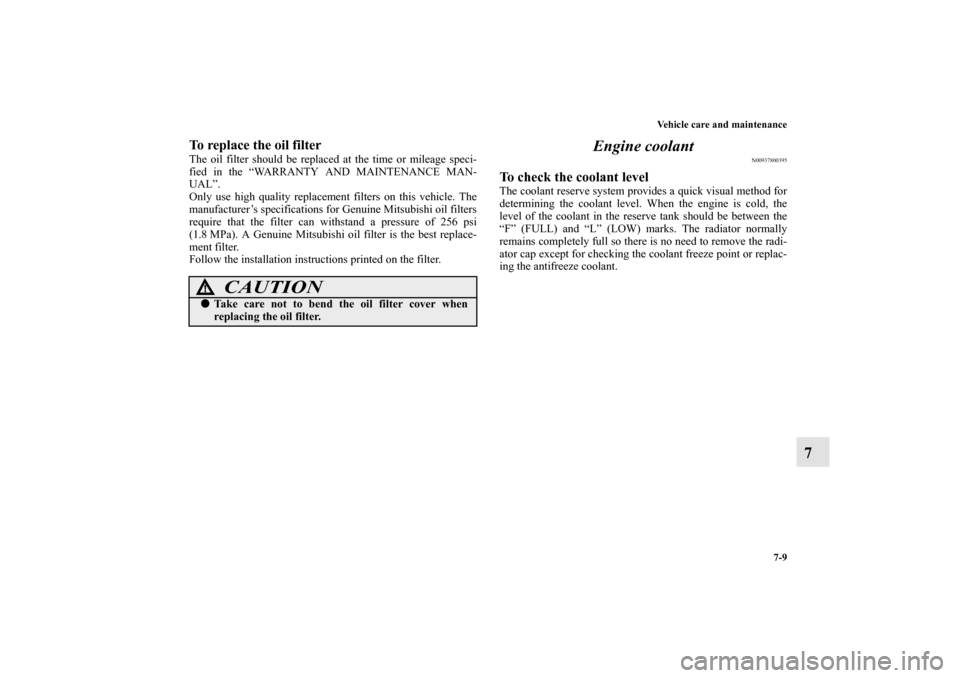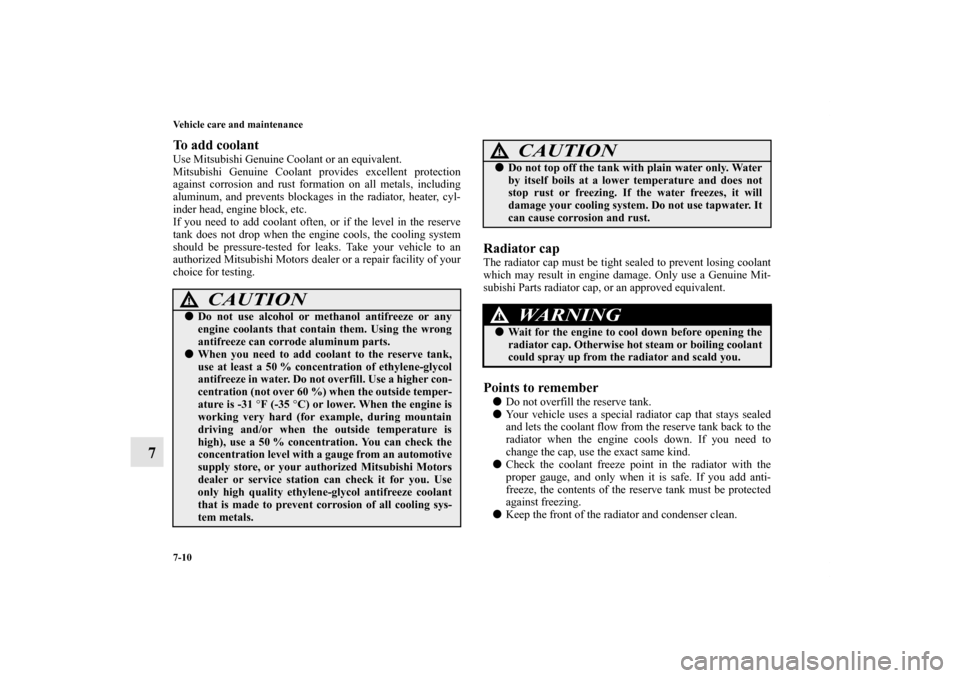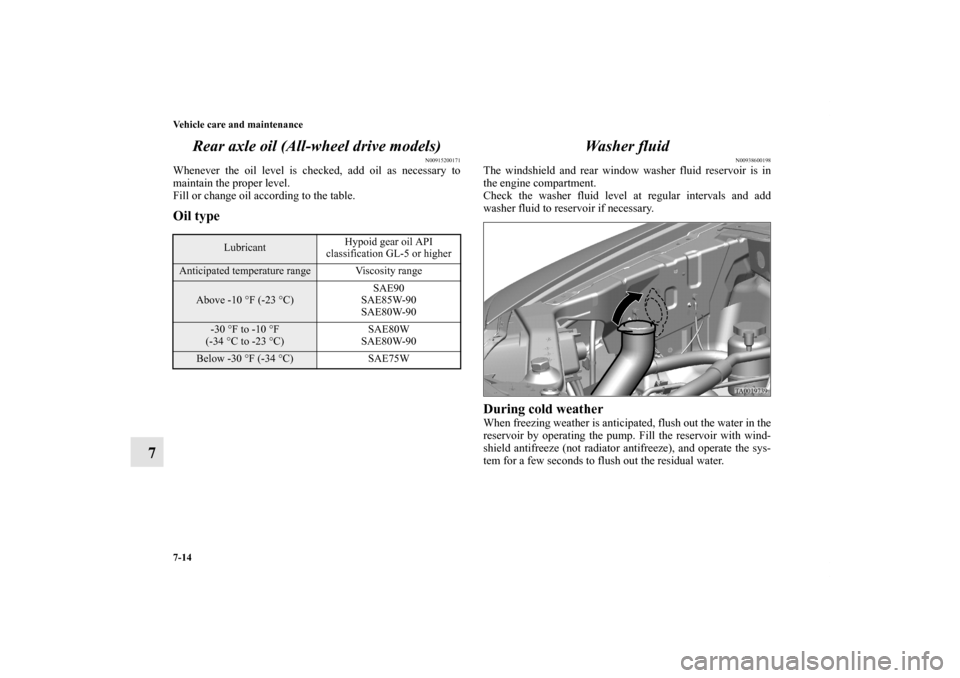Page 433 of 514

7-6 Vehicle care and maintenance
7View of the engine compartment
N00937600595
Engine oil and oil filter
N00937700844
To check and refill engine oil It is normal for an engine to use oil. You may need to add oil
between the recommended oil change intervals. Before starting
the engine, check the engine oil level. Refill if necessary.
To check the oil level, remove the dipstick, wipe it off, and
gently insert it all the way into the crankcase. Slowly remove it
again. The oil level must not go above the line on the dipstick.
If the level does not reach the line, which shows the smallest
amount of oil required, remove the oil filler cap on the engine
valve cover, and fill to within the “Good” range.
1- Power steering fluid reservoir
2- Brake fluid
3- Battery
4- Windshield and rear window washer fluid reservoir
5- Engine oil level dipstick
6- Radiator cap
7- Engine oil filler cap
8- Automatic transaxle fluid level dipstick
9- Engine coolant reservoir
10- Air cleaner filter
Good
BK0121600US.book 6 ページ 2010年4月12日 月曜日 午前10時39分
Page 434 of 514

Vehicle care and maintenance
7-7
7
NOTE�Engine oil consumption is greatly influenced by payload,
engine speed, etc.
�The engine oil will deteriorate rapidly if the vehicle is
subjected to severe conditions (for example, repeated
operation on rough roads, in mountainous regions, on
roads with many uphill and downhill gradients, or over
short distances). Consequently, the oil will require earlier
replacement in accordance with the schedule in the
“WARRANTY AND MAINTENANCE MANUAL”.
Engine oil identification markMitsubishi Motors recommends using only engine oils with the
ILSAC certification symbol on the front of the container.
CAUTION
!�Overfilling the crankcase will cause oil aeration and
loss of oil pressure, which could damage the engine.
WA R N I N G
!�Used engine oil is poisonous, and can damage your
skin. Prolonged and repeated contact may cause
serious skin disorders, including dermatitis and can-
cer. Don’t let used oil touch your skin. Wash thor-
oughly after working with it.�Keep used oil out of the reach of children.
ILSAC certification symbol
BK0121600US.book 7 ページ 2010年4月12日 月曜日 午前10時39分
Page 435 of 514
7-8 Vehicle care and maintenance
7
If you cannot find oils with the ILSAC certification symbol,
use an API classification SM oil with the following label.
This mark appears on the top of the oil container and tells you
two important things about the oil.
Recommended engine oil viscosityUse engine oil with the proper thickness for the outdoor tem-
peratures where you will be driving.
SAE 5W-20 engine oil is strongly recommended for optimum
fuel economy and cold starting.
1- The top portion shows the quality of the oil.
2- The center portion shows the SAE grade of the oil viscosity.API service symbolBK0121600US.book 8 ページ 2010年4月12日 月曜日 午前10時39分
Page 436 of 514

Vehicle care and maintenance
7-9
7
To replace the oil filterThe oil filter should be replaced at the time or mileage speci-
fied in the “WARRANTY AND MAINTENANCE MAN-
UAL”.
Only use high quality replacement filters on this vehicle. The
manufacturer’s specifications for Genuine Mitsubishi oil filters
require that the filter can withstand a pressure of 256 psi
(1.8 MPa). A Genuine Mitsubishi oil filter is the best replace-
ment filter.
Follow the installation instructions printed on the filter.
Engine coolant
N00937800395
To check the coolant level The coolant reserve system provides a quick visual method for
determining the coolant level. When the engine is cold, the
level of the coolant in the reserve tank should be between the
“F” (FULL) and “L” (LOW) marks. The radiator normally
remains completely full so there is no need to remove the radi-
ator cap except for checking the coolant freeze point or replac-
ing the antifreeze coolant.
CAUTION
!�Take care not to bend the oil filter cover when
replacing the oil filter.
BK0121600US.book 9 ページ 2010年4月12日 月曜日 午前10時39分
Page 437 of 514

7-10 Vehicle care and maintenance
7
To add coolant Use Mitsubishi Genuine Coolant or an equivalent.
Mitsubishi Genuine Coolant provides excellent protection
against corrosion and rust formation on all metals, including
aluminum, and prevents blockages in the radiator, heater, cyl-
inder head, engine block, etc.
If you need to add coolant often, or if the level in the reserve
tank does not drop when the engine cools, the cooling system
should be pressure-tested for leaks. Take your vehicle to an
authorized Mitsubishi Motors dealer or a repair facility of your
choice for testing.
Radiator capThe radiator cap must be tight sealed to prevent losing coolant
which may result in engine damage. Only use a Genuine Mit-
subishi Parts radiator cap, or an approved equivalent.Points to remember �Do not overfill the reserve tank.
�Your vehicle uses a special radiator cap that stays sealed
and lets the coolant flow from the reserve tank back to the
radiator when the engine cools down. If you need to
change the cap, use the exact same kind.
�Check the coolant freeze point in the radiator with the
proper gauge, and only when it is safe. If you add anti-
freeze, the contents of the reserve tank must be protected
against freezing.
�Keep the front of the radiator and condenser clean.
CAUTION
!�Do not use alcohol or methanol antifreeze or any
engine coolants that contain them. Using the wrong
antifreeze can corrode aluminum parts. �When you need to add coolant to the reserve tank,
use at least a 50 % concentration of ethylene-glycol
antifreeze in water. Do not overfill. Use a higher con-
centration (not over 60 %) when the outside temper-
ature is -31 °F (-35 °C) or lower. When the engine is
working very hard (for example, during mountain
driving and/or when the outside temperature is
high), use a 50 % concentration. You can check the
concentration level with a gauge from an automotive
supply store, or your authorized Mitsubishi Motors
dealer or service station can check it for you. Use
only high quality ethylene-glycol antifreeze coolant
that is made to prevent corrosion of all cooling sys-
tem metals.
�Do not top off the tank with plain water only. Water
by itself boils at a lower temperature and does not
stop rust or freezing. If the water freezes, it will
damage your cooling system. Do not use tapwater. It
can cause corrosion and rust.
WA R N I N G
!�Wait for the engine to cool down before opening the
radiator cap. Otherwise hot steam or boiling coolant
could spray up from the radiator and scald you.
CAUTION
!
BK0121600US.book 10 ページ 2010年4月12日 月曜日 午前10時39分
Page 440 of 514
Vehicle care and maintenance
7-13
7
Fluid typeUse only “DIAMOND ATF SP III” transaxle fluid to ensure
optimum transaxle performance. Special additives Mitsubishi Motors Corporation does not recommend the addi-
tion of any fluid additives to the transaxle.
Transfer oil (All-wheel drive models)
N00938400170
Whenever the transfer oil level is checked, add oil as necessary
to maintain the proper level.
Fill or change the oil according to the table.Oil type
Lubricant Hypoid gear oil API classification GL-5
Viscosity range SAE 90
BK0121600US.book 13 ページ 2010年4月12日 月曜日 午前10時39分
Page 441 of 514

7-14 Vehicle care and maintenance
7Rear axle oil (All-wheel drive models)
N00915200171
Whenever the oil level is checked, add oil as necessary to
maintain the proper level.
Fill or change oil according to the table.Oil type
Wa s h e r f l u i d
N00938600198
The windshield and rear window washer fluid reservoir is in
the engine compartment.
Check the washer fluid level at regular intervals and add
washer fluid to reservoir if necessary. During cold weatherWhen freezing weather is anticipated, flush out the water in the
reservoir by operating the pump. Fill the reservoir with wind-
shield antifreeze (not radiator antifreeze), and operate the sys-
tem for a few seconds to flush out the residual water.
LubricantHypoid gear oil API
classification GL-5 or higher
Anticipated temperature range Viscosity range
Above -10 °F (-23 °C)SAE90
SAE85W-90
SAE80W-90
-30 °F to -10 °F
(-34 °C to -23 °C)SAE80W
SAE80W-90
Below -30 °F (-34 °C) SAE75W
BK0121600US.book 14 ページ 2010年4月12日 月曜日 午前10時39分
Page 453 of 514

7-26 Vehicle care and maintenance
7
Replacing tires and wheels
N00939600283
Tire maintenance
N00939700138
The following maintenance steps are recommended:
�Check tire pressures regularly. �Have regular maintenance done on the wheel balance and
front and rear suspension alignment.
�Rotate your tires regularly as described in the “Tire rota-
tion” section on page 7-27.
Tread wear indicators
N00939800168
Tread wear indicators are built into the original equipment tires
on your vehicle to help you know when your tires should be
replaced. Many states have laws requiring that you replace
your tires at this point.
These indicators are molded into the bottom of the tread
grooves and will appear when the tire tread is worn down to
1/16 inch (1.6 mm).
CAUTION
!�Avoid using different size tires from the one listed
and the combined use of different types of tires, as
this can affect driving safety.
Refer to “Tires and wheels” on page 9-7.�On all-wheel drive vehicles, always use tires of the
same size, type, and brand that have no wear differ-
ences. Using tires of different size, type, brand or
degree of wear, will increase the differential oil tem-
perature, and result in possible damage to the driv-
ing system. Further, the drivetrain will be subjected
to excessive loading, possibly leading to oil leakage,
component seizure, or other serious problems.�As your vehicle is equipped with a tire pressure
monitoring system, use only Mitsubishi genuine
wheels.
Other wheels do not permit correct installation of
tire inflation pressure sensors and can cause air
leakage and sensor failure, which would not be cov-
ered by your vehicle’s warranty.
See an authorized Mitsubishi Motors dealer when
you replace a tire or wheel.
1- Location of the tread wear indicator
2- Tread wear indicator
BK0121600US.book 26 ページ 2010年4月12日 月曜日 午前10時39分